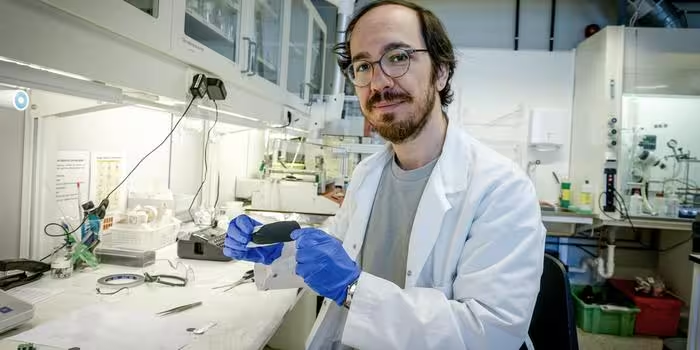6 Minutes
Why lithium‑sulfur batteries matter — and what’s holding them back
Lithium‑sulfur (Li‑S) batteries are emerging as a compelling alternative to today's lithium‑ion cells for electric vehicles (EVs) and long‑range applications. Sulfur is abundant and inexpensive, Li‑S cells can store more energy by weight, and early designs offer improved safety and faster charging. Yet a persistent challenge — the so‑called shuttle effect — has prevented Li‑S chemistry from achieving commercial scale.
The shuttle effect arises when lithium polysulfides (LPS), intermediate sulfur species produced during charge and discharge, dissolve in the electrolyte and migrate between the cathode and anode. This migration causes active material loss, rapid capacity fade and short cycle life. In practical terms, many experimental Li‑S cells that might initially rival lithium‑ion energy density still lose usable range after only a few hundred full charge/discharge cycles.
Researchers at the Norwegian University of Science and Technology (NTNU) have targeted this bottleneck with a novel approach that modifies the battery separator rather than reengineering cathodes or electrolytes. Their solution — a patented ultra‑thin coating called HiSep‑II — functions as a selective filter that blocks harmful polysulfides while permitting lithium ions to pass freely, addressing the core mechanism behind the shuttle effect.
HiSep‑II: an ultra‑thin smart separator coating
Inside every rechargeable battery a separator physically divides the positive and negative electrodes to prevent short circuits while allowing ionic conduction. The HiSep‑II innovation is a super‑thin coating applied to the separator's outer surface. Unlike thicker membranes or complex chemical traps, this coating is designed to be lightweight, manufacturable at scale and compatible with existing lithium‑based cells.
How the smart filter works
HiSep‑II acts as a size‑ and chemistry‑selective barrier. Its engineered surface and porosity retain dissolved lithium polysulfides on the cathode side while permitting lithium ions (Li+) to move between electrodes during charge and discharge. By curtailing polysulfide diffusion, the coating prevents the continual loss of active sulfur and the formation of passivating layers on the anode — the mechanisms that normally drive rapid capacity decline in Li‑S cells.
NTNU researchers secured intellectual property for the technology through the HiSep‑II project and are collaborating with NTNU Technology Transfer (TTO) to bring the coating to market. The team emphasizes that the production process is designed to be environmentally friendly and readily scalable, and the coating can be incorporated into current Li‑based battery manufacturing lines.

Performance gains, weight savings and broader implications
Laboratory tests conducted at NTNU’s Gløshaugen facilities indicate a substantial improvement in cycle life for Li‑S cells fitted with the HiSep‑II coating. Typical baseline Li‑S cells in the lab reach about 200 full charge/discharge cycles before significant capacity loss. With the HiSep‑II separator, cycle life increased to roughly 1,000 cycles — a fivefold extension that moves Li‑S chemistry into a far more practical range for many applications.
Beyond cycle life, HiSep‑II offers system‑level benefits. The researchers estimate that an 800‑volt EV battery pack incorporating the technology could be reduced in mass by more than 200 kilograms, because the higher energy density and improved retention of active material allow designers to use less redundancy and fewer heavy structural components. The result would be lighter vehicles, improved efficiency and longer driving range.
Safety and cost are additional advantages: sulfur is inexpensive and plentiful, and the coating’s compatibility with existing lithium technologies makes it an attractive candidate for aviation, aerospace, drones, maritime transport and grid storage — sectors where longevity, weight and stability are critical.
Expert Insight
"Extending cycle life by a factor of five while maintaining low weight is a game changer for Li‑S adoption," says Dr. Maria Chen, a battery systems engineer with experience in aerospace power systems. "The emphasis on the separator is smart: it addresses a transport problem at the materials interface rather than forcing complex new cathode chemistries or exotic electrolytes. If independent tests confirm the lab results and the coating scales reproducibly, HiSep‑II could unlock Li‑S for high‑value mobility and storage uses where energy density and safety matter most."
This independent‑sounding perspective underscores two realities: third‑party validation is essential and system integration — from cell manufacturing through pack design and thermal management — will determine real‑world performance.
Scaling, testing and commercial outlook
Before HiSep‑II reaches commercial products, several steps remain. Independent third‑party testing must verify long‑term stability, safety, and consistent performance when the coating is integrated into full cells and battery packs. Manufacturing trials will need to show the coating can be applied reliably at high throughput with consistent quality and acceptable cost.
NTNU's TTO is actively seeking industrial partners to finance further patenting and to lead scale‑up and validation tests. Kristina Nydal, a business developer at TTO, highlights the technology’s cross‑sector potential: "Our goal is to license HiSep‑II so it can be used from EVs to large‑scale renewable energy storage. It looks promising for sectors where longevity and safety are non‑negotiable."
Commercial uptake will depend on documented lifetime gains, cost per kilowatt‑hour, integration complexity and regulatory approvals for new battery components. But the concept — a slimmer, scalable separator coating that mitigates the shuttle effect — offers a pragmatic route to making Li‑S cells commercially viable without wholesale retooling of cell chemistry.
Conclusion
HiSep‑II is an ultra‑thin separator coating developed at NTNU that targets the lithium polysulfide shuttle effect, the primary cause of rapid capacity loss in lithium‑sulfur batteries. Lab results indicate up to a fivefold increase in cycle life and potential system‑level weight savings that could transform EV battery packs, aviation power systems and energy storage. The technology's manufacturability, environmental compatibility and compatibility with existing lithium‑based production make it a promising candidate for commercialization — provided independent validation and industrial scale‑up confirm the lab performance. If those milestones are met, HiSep‑II could be a decisive step toward affordable, lightweight, and longer‑lasting Li‑S batteries for a wide range of transport and storage applications.
Source: techxplore


Leave a Comment